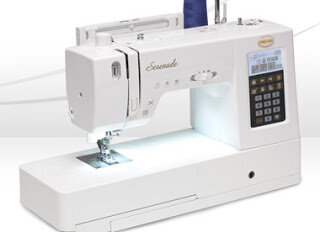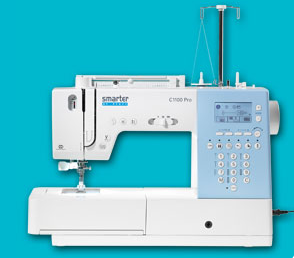Sewing machine shopping: What I learned
As I mentioned yesterday, I spent the better part of last week shopping for a new sewing machine. Say hello to my Janome Horizon 7700!
I've only had her for a few days, so I haven't used a lot of the advanced features or quilted yet, but so far she is a rock star! Sews like a dream, soooo quietly and steadily. Every time I walk past, I just have to give her a little pat. : )
But now that the process is done and I've got my beautiful new machine, I have one simple question: Why does sewing-machine shopping have to be so confusing? It isn't easy to compare models and features when most dealers carry only one or two makes. I don't like getting the hard-sell from salespeople, and what's with all the secrecy about what people are actually paying for these things? It's worse than buying a used car!
So I spent an intense couple of days reading everything I could about the various models and test-driving machines at dealers. Here's my wish-list of the features I was looking for:
• a larger throat space to fit quilts under (my old Baby Lock had about 7.5" from the needle to the side of the machine)
• a dual-feed system (which means it feeds the fabric from both underneath and above)
• needle up-down feature
• auto needle threader and thread cutter (my Baby Lock had these, so I don't think live without them now!)
• knee lift for the presser foot (my Baby Lock came with this, but I could never use it comfortably with that machine)
• good extension table for quilting
• excellent free-motion quilting feet/accessories—preferably included
With that list in hand, it didn't take me long to narrow down some contenders via the reviews. My "finalists" are below. I found both The Quilting Board and Patternreview.com to be good sources for reviews, although on Patternreview.com you have to register to read reviews more than six months old, and I was unable to get their log-in screen to work (it kept re-directing me in a loop). There are also Yahoo user groups for certain brands/models, which may be helpful—just do a Google search for a specific group.
A note about prices: The thing that most drives me crazy about shopping for sewing machines is the fact that you can't see prices online, and nobody ever pays the actual retail price on a machine. As an avid online shopper and price-comparer, this makes me insane. So for most of these machines, I'm including a "fair price" estimate. Please take this estimate with a grain of salt. These are my own rough estimates, based on what I was quoted at dealers and/or what a few random people reported paying for it in reviews and online forums. So your mileage may vary! For certain models, prices truly were all over the map. Look for sales and floor models, try shopping at quilt shows for special show pricing, and always try bargaining with the dealers. Yes, you can and should haggle for sewing machines.
The Baby Lock Serenade
Fair price: $1,100 to $1,200
This was the first machine I looked at. I liked the idea of buying an upgraded Baby Lock, since I mostly liked my old one and staying with a familiar interface sounded good. The feed dog issue I've been experiencing with my old machine doesn't seem to be a common problem, since I can't find anything about it online, which made me more confident about buying another Baby Lock. The Serenade has a well-reviewed dual-feed system and a 9mm stitch width, which would be great for straight-line quilting. But with only 8 5/8" of throat space, it wouldn't be much of an upgrade for me in that area. And many of the machine's overall reviews weren't great. So in the end I didn't look closely at this one.
The Baby Lock Symphony
Fair price: around $2,000
This was a great option for me and it gets fabulous reviews. Really the only big negative on this machine: No dual-feed mechanism. But the 10" of throat space helped make up for that! It also has a pivot feature that raises the foot automatically when you stop sewing with the needle-down option on. In my test-drives of this machine, I found the pivot feature worked well—it seemed to intuitively know when I was slowing down (and thus kept the foot down) and when I really was stopping. And how's this for crazy: You can even sew sideways on the Symphony! It sews very slowly in sideways mode, but it does it. I could see the pivot and sideways-sewing features being useful for straight-line quilting when you're turning a lot of corners. My Baby Lock dealer quoted me $1,999 for this one (with some haggling—they started out at $2,200).
Brother Laura Ashley Innovis NX-2000
Fair price: Around $1,800- $1,900?
I didn't even consider this machine or read the reviews of it before I went shopping. But one of the dealers explained that Brothers and Baby Locks are made by the same parent company, so this machine is actually the Symphony's twin. The user interface, the threading and bobbin winding mechanisms, etc., are all more or less identical. But this machine is a few hundred dollars cheaper! I asked the dealer why it's less expensive, and she said, "Because it's a Brother." Honestly, this had more the effect of putting me off the Symphony than interesting me in the Brother. Does that mean Baby Locks are overpriced? Is Brother the victim of a bad rap? I don't get it. But if you're interested in a Symphony, it's probably worth checking into this one as well. A little research into what the differences really are could save you some money. My dealer had this machine priced at $1,899, which makes me think, with haggling, it could be purchased for less.
The Pfaff Smarter 1100 Pro
Fair price: Didn't research prices, sorry.
Rachel of Stitched In Color recently bought this machine and I read about her machine-buying experiences with interest (here and here). Her description of the Pfaff Smarter sounds great, but unfortunately the nearest Pfaff dealer to me is local quilt shop where I have had bad customer service experiences in the past. A good relationship with your dealer is almost as important as the machine itself, so I didn't try this one out (or any Pfaffs).
The Janome 6600
Fair price: between $1,100 and $1,500
Very good reviews, lots of useful features, a reasonable 9" of throat space, and Janome's Accufeed dual-feed mechanism. That's a lot of bang for your buck! The biggest drawback to this one seems to be that it doesn't have a free arm (which means you can't make the bottom part of the machine smaller to put sleeves, pants legs, bags, etc., around it). My old machine has a free arm, and while I certainly didn't use it frequently, I used it often enough to wonder if I might miss it. And I've been wanting to try sewing more clothes for the girls, so if that ever becomes reality, the free arm would be important to have.
The Janome Horizon 7700
Fair price: between $2,100 and $2,500
This one has 11" of throat space—what? That's huge! That's a full 2" more than the 6600, and 3.5" more than my old machine! It has the Accufeed system and all the other bells and whistles I've been looking for, and people rave about the free-motion quilting capabilities on this baby. This is the machine Leah Day of the Free Motion Quilting Project uses and loves. You can read her reviews here and here. There are some negative reviews out there of the Horizon, but most of those seem to center on a design flaw in the original 1/4" piecing foot, which has since been fixed. Every registered Horizon owner was sent a new version of the 1/4" piecing foot when it was released—they didn't even have to ask for it. That's good customer service (and a reason to remember to register your machine!). Some people don't like the click-wheel stitch selector, but I love it—if you've ever used an iPod, you'll find it familiar and intuitive. The lowest price I found for this machine was $2,399 for new, $2,299 for a floor model that was on the floor for about 3 months. You may see a lot of higher prices for this machine as well—I think the Horizon was more expensive when it first came out, but prices seem to have dropped since then.
Viking Sapphire 875
Fair price: around $2,000?
This machine has 10" of throat space and a sensor system that automatically adjusts the presser foot based on the thickness of your fabric, which sounds interesting. But for the price, it was missing some features I wanted, like dual-feed and a knee lift. And there aren't many reviews out there on it. So in the end I didn't try this one out.
Berninas—honestly, I didn't even look into Berninas. I've heard they're very well-made, but with price tags to match, and none of the dealers I visited carry them.
To tell the truth, I had fully expected to leave the store with a Baby Lock Symphony. It had everything I wanted with the exception of the dual-feed mechanism. Plus it was a Baby Lock, a brand I was already familiar with. But when I sat down at the Janome Horizon, I fell in love. Something about that machine just clicked for me. And that's really what it's all about with sewing machines—what felt right for me may not be ideal for you, and vice versa. Regardless of features and pricing and everything I said above, you need to test-drive the machines to find the perfect one for you. And it really doesn't matter how many features a machine has or whether other people use those features and like them. The most important thing is that it has the features you use and need. The best way to know that is to spend as much time as possible testing them out.
So the Horizon was my choice! After spending the last several years working on a machine that was missing key features, I decided it would be worth a few hundred dollars more to get my dream machine. I ended up buying the floor model for $2299, and the dealer threw in this custom table for $200. (I priced out the table elsewhere and other dealers were asking $350 to $400 for it.) The Horizon does come with a huge clear extension platform, but I saw a Horizon set up on this drop-in table and couldn't get it out of my head! This all means that I'm finally sewing at the correct height and have an amazing surface for quilting, flush with the bed of the machine. I think when I'm quilting I'll try to push the table up against a wall or possibly next to our large dining room table (if it's the right height) for the perfecto quilting set-up!
I'll write a full review of the machine after I can spend a little more time getting to know her. In the meantime, I hope you'll find my sewing machine round-up a helpful starting point if you're in the market any time soon.










